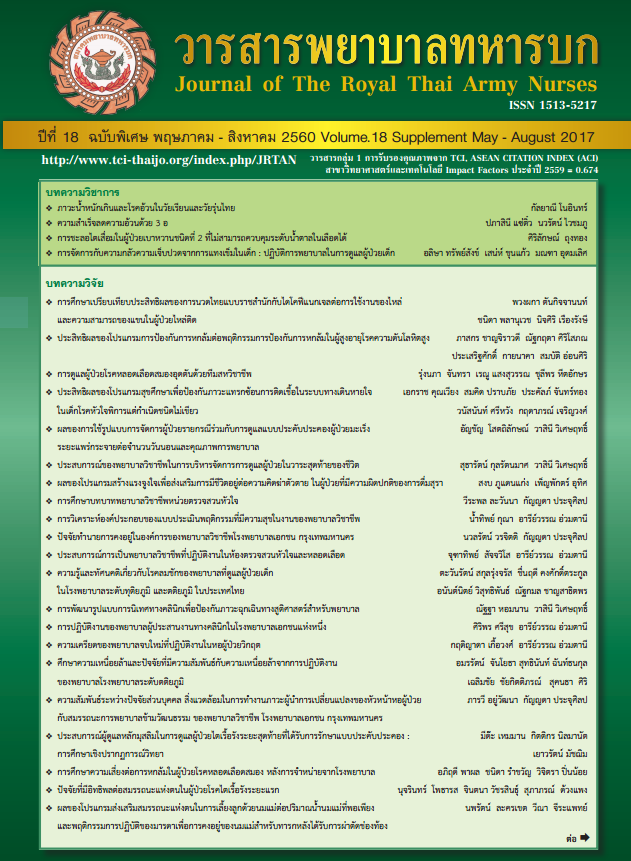ปัจจัยทำนายพฤติกรรมการป้องกันวัณโรคของผู้สัมผัสร่วมบ้านกับผู้ป่วย วัณโรคปอดที่พักอาศัยในกรุงเทพมหานครและปริมณฑล
Keywords:
วัณโรค, ผู้สัมผัสร่วมบ้าน, การป้องกันวัณโรค, tuberculosis contacts, preventive behavior, Health Belief ModelAbstract
การวิจัยเชิงพยากรณ์นี้มีวัตถุประสงค์เพื่อศึกษาปัจจัยทำนายพฤติกรรมการป้องกันวัณโรคของผู้สัมผัสร่วมบ้านกับผู้ป่วยวัณโรคปอดที่พักอาศัยในกรุงเทพมหานครและปริมณฑล กลุ่มตัวอย่าง คือ ผู้สัมผัสร่วมบ้านกับผู้ป่วยวัณโรคปอด 212 คน เก็บข้อมูลโดยใช้แบบสอบถาม วิเคราะห์ข้อมูลด้วยสถิติพรรณนา สัมประสิทธิ์สหสัมพันธ์เพียร์สัน และสถิติถดถอยพหุคูณ = 72.55, SD = 8.62) ปัจจัยที่สัมพันธ์กับพฤติกรรมการป้องกันวัณโรค ได้แก่ การรับรู้โอกาสเสี่ยงของการเป็นวัณโรค (r = .241) การรับรู้ความรุนแรงของวัณโรค (r = .197) สิ่งชักนำให้เกิดการปฏิบัติเพื่อป้องกันวัณโรค (r = .191) การรับรู้ประโยชน์ของการป้องกันวัณโรค (r = .169) และความสัมพันธ์กับผู้ป่วย (r = -.136) ตัวแปรต้นร่วมกันทำนายพฤติกรรมการป้องกันวัณโรคได้ ร้อยละ 15.70(R2 = .157, F = 3.099, p< .05) ปัจจัยที่สามารถทำนายได้ คือ การรับรู้โอกาสเสี่ยงต่อการติดเชื้อวัณโรค (ß = .178, p<.05)และสิ่งชักนำให้เกิดการปฏิบัติพฤติกรรมการป้องกันโรควัณโรค (ß = .137, p<.05)ผลการวิจัยสามารถนำไปพัฒนาการดูแล โดยเน้นการรับรู้ความเสี่ยงต่อการติดเชื้อวัณโรค การให้คำแนะนำในการป้องกันวัณโรค ด้านการเรียนการสอนพยาบาลควรให้มีการเรียนรู้และส่งเสริมให้เกิดพฤติกรรมการป้องกันวัณโรคที่เหมาะสมในกลุ่มผู้ที่อยู่ร่วมบ้านกับผู้ป่วยวัณโรค
The Factors Predicting Tuberculosis Preventive Behaviors Among The Tuberculosis Contacts In The Bangkok Area And Perimeter
The purposes of this predictive descriptive research were to examine the factors influencing tuberculosis preventive behaviors among tuberculosis contacts in the Bangkok area and perimeter. A total of 212 tuberculosis contacts were included. Data were collected by using the questionnaire. Data were analyzed using descriptive statistics, Pearson’s correlation coefficient, and multiple regression analysis. The results revealed that the tuberculosis contacts = 72.55, SD = 8.62). Perceived susceptibility of tuberculosis infection (r = .241), perceived severity of tuberculosis (r = .197), cues to action for tuberculosis prevention (r = .191), perceived benefit of tuberculosis prevention (r = .169), and close relative variable (r = -.136) had the statistically significant correlations with tuberculosis preventive behaviors. All of variables to-gether explained 15.70% of the variance in tuberculosis preventive behaviors (R2 = .157, F = 3.099, p<.05). The factors with the influence as predictive factors were perceived susceptibility to tuberculosis infection (ß = .178, p<.05), followed by cues to action for tuberculosis prevention (ß = .137, p<.05). The findings can be applied to develop the tuberculosis care, promoting the perceived susceptibility to tuberculosis infection, and health education for tuberculosis prevention, and used for nursing education to promote the tuberculosis preventive behaviors among tuberculosis contacts.
Downloads
Downloads
How to Cite
Issue
Section
License
บทความหรือข้อคิดเห็นใดใดที่ปรากฏในวารสารพยาบาลทหารบกเป็นวรรณกรรมของผู้เขียน ซึ่งบรรณาธิการหรือสมาคมพยาบาลทหารบก ไม่จำเป็นต้องเห็นด้วย
บทความที่ได้รับการตีพิมพ์เป็นลิขสิทธิ์ของวารสารพยาบาลทหารบก
The ideas and opinions expressed in the Journal of The Royal Thai Army Nurses are those of the authors and not necessarily those
of the editor or Royal Thai Army Nurses Association.






